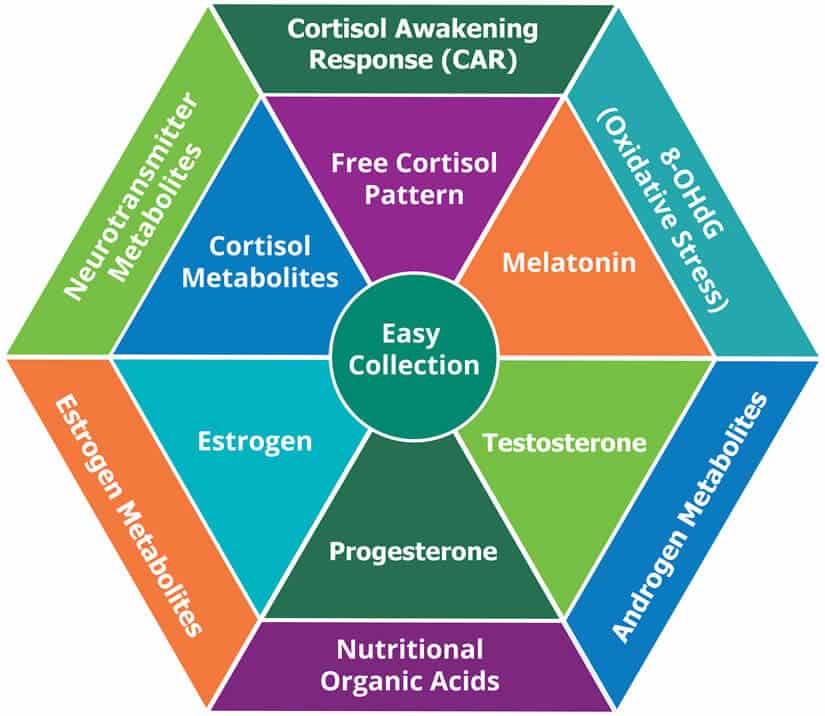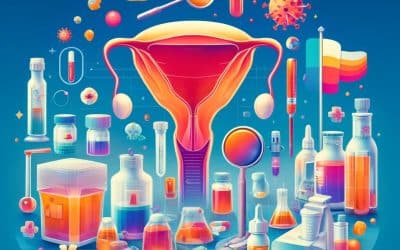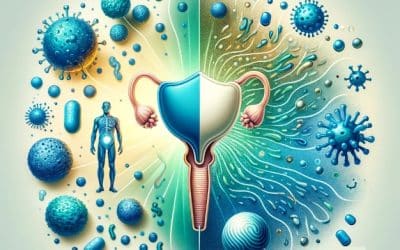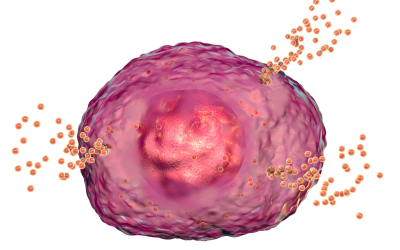Test, don’t Guess
I am writing this blog because I have been lurking on a few fertility Facebook groups and I am shocked when I see people are not using the right tools to investigate their hormones to improve fertility.
Hands down, I feel the Dutch test is the GOLD standard for anyone struggling to conceive or just wants to know what is going on inside their body to improve fertility.
To learn more about this test, visit this website
So why is the test superior to improve fertility? This is because it can provide insight as to what is really going on inside your body.
Your hormones matter!
Progesterone is very important for conception! Progesterone (Pg) is a hormone secreted after ovulation by the ovaries (it can be made in the placenta and adrenal glands as well). It primarily regulates the condition of the inner lining (endometrium) of the uterus however like estrogen, its systemic effects are numerous. Low progesterone can contribute to poor follicle development and poor-quality corpus luteum. The normal range for women post ovulation is >6 mg/ml, and anything over 12 ng/ml is a strong progesterone production sufficient for conception.
Symptoms of low progesterone include
- Anxiety
- Infertility
- Insomnia
- Irritability
- Menorrhagia
- PMS/PMDD
Note: The Pg assessment is based off of two urine metabolites (a – Pregnanediol and b – Pregnanediol) that are extrapolated to provide an individual “serum equivalent” number that has been shown to correlate to serum Pg measurements.
Estrogen regulates the growth, development, and physiology of the human reproductive system. Estrogen is an important sex hormone produced primarily by the ovaries in premenopausal women and from circulating adrenal androgens in postmenopausal women. The biological actions of estrogen are mediated by binding to the estrogen receptors in target organs.
Estrogen metabolites must also be considered. E1 and E2 are both metabolized by three competing (2, 4, and 16-OH) pathways. Generally, metabolism that heavily favors 4-OH is considered a potential risk factor for estrogen-related cancers (although this is a complicated issue). Conversely, 2-OH metabolites (particularly 2-methoxy estrogens) are considered more protective.
Symptoms of low estrogen include
- Bone loss
- Hot flashes
- Insomnia
- Joint pain
- Skin issues
- Low sex drive
- Mood issues/brain fog
- Vaginal dryness
- Weight gain
- Night sweats
Symptoms high estrogen include:
- Acne
- Dysmenorrhea
- Menorrhagia
- Mood swings
- Swelling
- Tender breasts
- Weight gain
Testosterone (T) is made primarily from two locations. Some T is made throughout the body from the adrenal gland’s DHEA and androstenedione production. In pre-menopausal women, the ovaries also make some T.
Symptoms of low T include:
- Belly fat
- Bone loss
- Low energy
- Low sex drive
- Low muscle mass
- Mood issues/brain fog
Symptoms of high T include:
- Acne
- Aggression
- Bone/facial hair
- Thinning scalp hair/hair loss
- Causes of Low T include:
Low ovarian/adrenal output
- Low precursors (DHEA, androstenedione)
- Poor hypothalamic / pituitary communication
- Surgically removed ovaries
- Age
- Decreased blood flow to the glands
- Diabetes
- Elevated SHBG (decreased free T)
- Medications
- Zinc deficiency
Causes of high T include:
- Hyper-adrenal output
- Insulin/ insulin resistance
- Non-classical congenital adrenal hyperplasia
- PCOS
low levels of SHBG (high free T)
- Supplementation (T, Clomid, HCG)
How the Dutch can Improve Fertility
So how can the Dutch test help? It measures your hormone metabolites which gives you functionality of your hormones and will provide much better insight on fertility.
Take a look at the screen shot below to understand more.

Pregnanolone: the mother of your hormones
As you can see, pregnenolone is the mother of all hormones. It is the precursor to your DHEA and your Progesterone. You need adequate levels to improve fertility.
A big source of pregnenolone is from CHOLESTEROL. Your fertility doctor should be measuring your cholesterol levels, but also checking your blood sugar markers such as C peptide. Why blood sugar? It cn provide insight to your cholesterol production since insulin is the biggest driver of high or low cholesterol enzymatically.
Pregnenolone becomes DHEA- which must be sulfated to DHEA-S. This is another area that is often overlooked. Your sulfated DHEA is your STORED DHEA that your body stores to use when needed. If your levels of sulfated DHEA are low, then you do not have enough reserved for biological use. There are interventions to support this such as increasing sulfur in your diet to improve fertility.
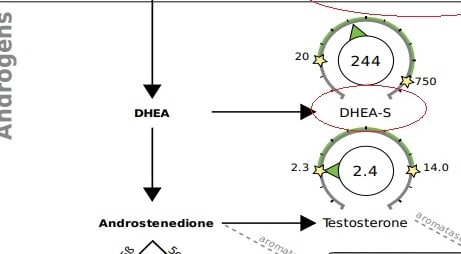
DHEA
Next you can see DHEA also becomes testosterone. This is important, as testosterone can aromatize to estrogen. Low testosterone can contribute to low estrogen. Testosterone is also involved in embryo development to improve fertility.
And finally, you can see that your estrogen metabolism is really important. There are 3 forms of estrogen, E1, E2 and E3. E2 (estradiol) is the most biologically active form. However, E1 (estrone) can go through enzymatic conversion via your CYP phase 1 enzymes to become more toxic, such as your 16-OH E1 or 4-OH E1.
High 16-OH can contribute to tumors, and high 4-OH is a risk for cancers especially breast cancer. Knowing your levels is critical in knowing your overall health of your hormones.
Next your estrogens go through methylation via an enzyme COMT. Many people have polymorphisms in this enzyme, and this can affect methylation.

Methylation
Methylation is very important for DNA synthesis and conception! This is one reason why folate is recommended during pregnancy. If methylation is low, it is recommended you run additional testing such a Nutrigenomic and Metabolomics testing. I use the Tree of Life for Genetics and Nutreval for metabolomics to understand what is going on with your biochemical pathways. Without this information, you will be playing in the dark.
I will be writing an entire blog on methylation soon! That is how important it is.
Adrenal hormones
But that is not all. This test also checks your cortisol levels.
Your adrenal glands produce both DHEA and cortisol. So if your total DHEA is low, this could be an adrenal issue! Stress greatly impairs adrenal function, and I see adrenal dysfunction widespread among my patients. Optimizing your adrenals is key to improve fertility.
The adrenal glands produce cortisol which is your fight or flight hormone. You may not know that healthy cortisol is needed for proper immune function, though too much can damage your internal organs.
This test will show you not only your “metabolized” cortisol but also free cortisol. Different patterns mean different things. Generally, if your body is converting cortisol into cortisone, it is because you have too much and it is trying to protect you from its affects. Each of these have specific interventions to improve fertility.

Organic Acids
And finally we have our organic acid section. This gives you a snapshot of your different important biomarkers for hormone health such as B12, B6, glutathione, catecholamines, melatonin and oxidative stress and DNA damage. Glutathione is a very important antioxidant, and low levels are often associated with oxidative stress.
Oxidative stress is not good for conception. It creates an unfavorable environment for implantation but also for proper cell division. In fact, one of the hallmarks of declining ovarian function is oxidative stress.
8-OHdg is a marker for DNA damage. I am shocked how many of my patients have high levels of this as young as 35! This right here could be the tell tale sign of frequent miscarriage.
As you may know, during cell division of the blastocyst, the chromosomes have to divide. If there is damage, they wont divide properly and your body senses this and promotes the pregnancy loss. Getting this level down is CRITICAL for your ability to conceive properly.
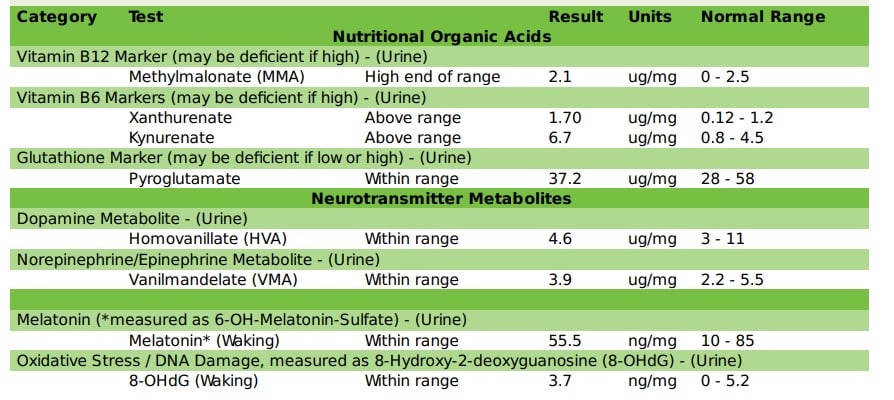
Dutch Cycle Mapping
For those who want more information on their monthly cycle, they also provide the Dutch cycle mapping.
It can give you insight as to when your hormones rise and can predict ovulation and your luteal phase health, which is critical for conception
As you can see, this example demonstrates this person has low estrogen throughout the month. She gets a rise around day 15-17, which indicates the ovulatory phase, but the progesterone does not rise until day 23. You generally want to see it rise fairly quickly after estrogen for a “healthy” cycle. This also shortens her luteal phase, which can be considered a “luteal phase defect”. Supporting progesterone with herbs such as Vitex and Maca can be helpful to improve the ovarian hormonal signaling.

So hopefully this provided a snap shot of why I love this test so much. Although my primary focus in my practice is bladder pain syndrome, I have a lot of patients who are also interested in fertility. If you are interested in learning more about how I can INVESTIGATE your fertility struggles, you can book a Discovery call to find out if we are a good match to work together.
Book here for your Discovery call! I would love to help you investigate and support your fertility journey!

